Family name: Ixioliriaceae Nakai
Synonym(s): [none]
Common name(s): ixiolirion family
*Number of genera/species: 1/4
List of genera records in GRIN-Global
seed
Fruit dehiscentdehiscent:
(v. dehisce) splitting open at maturity to release contents (of a fruit)
 , loculicidalloculicidal:
, loculicidalloculicidal:
type of capsular dehiscence, opening longitudinally through the locules (compare septicidal)
 capsulecapsule:
capsulecapsule:
a dry, dehiscent fruit formed by two or more carpels
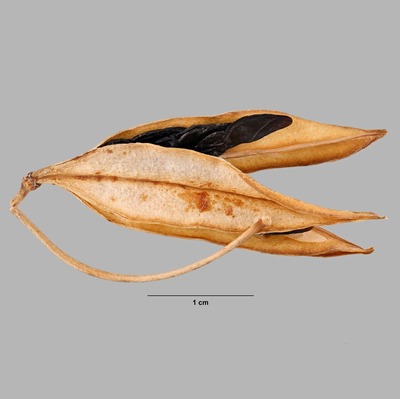 , opening at apexapex:
, opening at apexapex:
the point farthest from the point of attachment, or the "tip" of an organ
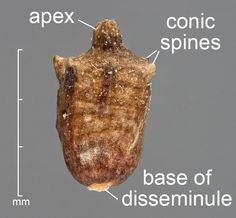 , 10 mm long, oblongoblong:
, 10 mm long, oblongoblong:
2D shape—much longer than broad with nearly parallel sides, corners are rounded or wedge shaped, tereteterete:
or wedge shaped, tereteterete:
approximately circular in cross section; width and thickness approximately equal
 or triangulartriangular:
or triangulartriangular:
2D shape—three relatively straight sides with distinct corners; more angular than teardrop-shaped in transectiontransection:
in transectiontransection:
a cross section; representing a plane made by cutting across an organ at a right angle to its length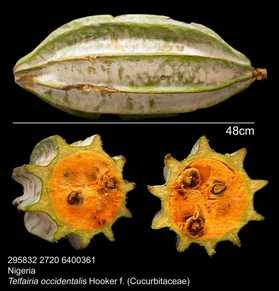 , stylar remnantsstylar remnants:
, stylar remnantsstylar remnants:
remnant of a style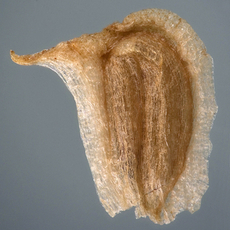 persistent, many seeded. Pericarppericarp:
persistent, many seeded. Pericarppericarp:
fruit wall or fruit coat
brown, ribbedribbed:
surface relief—wide, prominent, linear ridges that are generally rounded and longitudinally situated on the surface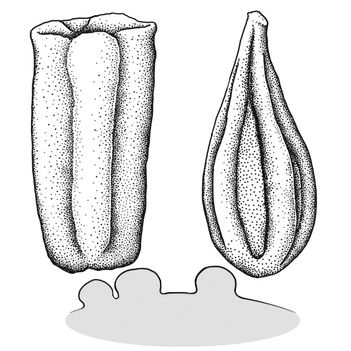 or striatestriate:
or striatestriate:
surface relief—having fine, parallel lines, grooves or ridges .
.
Seed oblongoblong:
2D shape—much longer than broad with nearly parallel sides, corners are rounded to teardrop-shapedteardrop-shaped:
to teardrop-shapedteardrop-shaped:
2D shape—widest point is toward one end of the fruit, the other end tapers sharply to a pointed end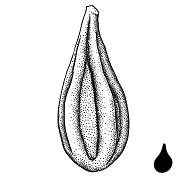 , slightly curvedcurved:
, slightly curvedcurved:
(of embryo) linear embryo is curved into an arch or horseshoe with the ends far apart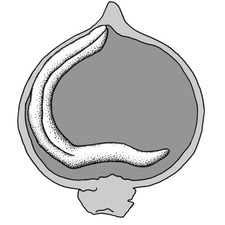 , beakedbeaked:
, beakedbeaked:
a usually firm, terminal appendage, sometimes tapered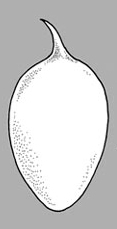 or pointed at one end. Seed coat black, with phytomelanphytomelan:
or pointed at one end. Seed coat black, with phytomelanphytomelan:
carbonaceous, opaque material that usually covers the seed coat to give it a black appearance, common in certain monocot families
, reticulatereticulate:
surface relief—netted, raised walls or concave grooves forming a net-like surface pattern with flat, concave, or convex interspaces .
.
Embryo fusiformfusiform:
spindle-shaped; broadest at the middle and tapering at both ends
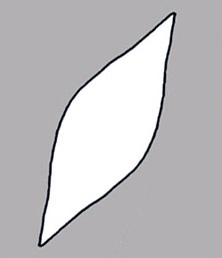 , straight, nearly as long as endospermendosperm:
, straight, nearly as long as endospermendosperm:
nutritive starch- and oil-containing tissue present in many seeds
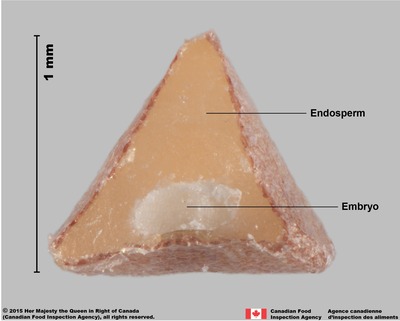 . Endospermendosperm:
. Endospermendosperm:
nutritive starch- and oil-containing tissue present in many seeds
 present.
present.
| Fruit | ||
| Type | capsulecapsule: a dry, dehiscent fruit formed by two or more carpels  |
|
| Size range | 10 mm long | |
| Shape(s) | oblong, cuneiform | |
| Surface relief | ribbed ribbed: surface relief—wide, prominent, linear ridges that are generally rounded and longitudinally situated on the surface  or striate or striate |
|
| Color(s) | brown | |
| Unique features | Brown, ribbedribbed: surface relief—wide, prominent, linear ridges that are generally rounded and longitudinally situated on the surface  or striatestriate: or striatestriate:surface relief—having fine, parallel lines, grooves or ridges  , capsulescapsules: , capsulescapsules:a dry, dehiscent fruit formed by two or more carpels  with persistent stylesstyles: with persistent stylesstyles:in a flower, the narrow and elongated part of the pistil between the stigma and the ovary; sometimes persisting in fruit 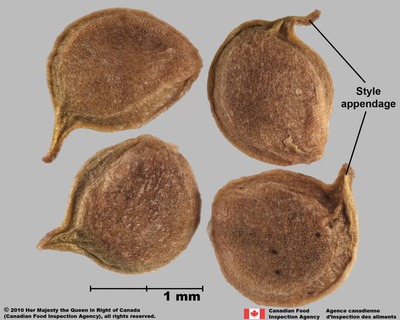 , dehiscing at their apicesapices: , dehiscing at their apicesapices:the point farthest from the point of attachment, or the "tip" of an organ  , with many phytomelanphytomelan: , with many phytomelanphytomelan:carbonaceous, opaque material that usually covers the seed coat to give it a black appearance, common in certain monocot families encrusted seeds. |
|
| Seed | ||
| Shape(s) | ovoid, teardrop-shapedteardrop-shaped: 2D shape—widest point is toward one end of the fruit, the other end tapers sharply to a pointed end  , oblong , oblong |
|
| Surface relief | reticulatereticulate: surface relief—netted, raised walls or concave grooves forming a net-like surface pattern with flat, concave, or convex interspaces  |
|
| Color(s) | black | |
| Unique features | Small, black, reticulatereticulate: surface relief—netted, raised walls or concave grooves forming a net-like surface pattern with flat, concave, or convex interspaces  , teardrop-shapedteardrop-shaped: , teardrop-shapedteardrop-shaped:2D shape—widest point is toward one end of the fruit, the other end tapers sharply to a pointed end  seeds slightly curvedcurved: seeds slightly curvedcurved:(of embryo) linear embryo is curved into an arch or horseshoe with the ends far apart  , beakedbeaked: , beakedbeaked:a usually firm, terminal appendage, sometimes tapered  , with phytomelanphytomelan: , with phytomelanphytomelan:carbonaceous, opaque material that usually covers the seed coat to give it a black appearance, common in certain monocot families . |
|
| Other | ||
| Embryo | fusiform, straight, nearly as long as endosperm | |
| Nutritive tissuenutritive tissue: tissue within the seeds that nourishes the developing embryo; such as endosperm, perisperm, or chalazosperm in angiosperms; megagametophyte in gymnosperms |
endosperm endosperm: nutritive starch- and oil-containing tissue present in many seeds  present present |
|
Narrow distribution in Eurasia.
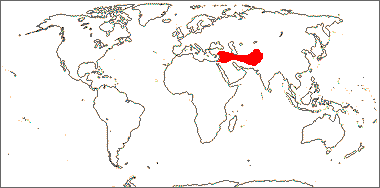
Distribution map courtesy of Angiosperm Phylogeny Website.
Baskin and Baskin 2021Baskin and Baskin 2021:
Baskin C and Baskin J. 2021. Relationship of the lateral embryo (in grasses) to other monocot embryos: A status up-grade. Seed Science Research 31 (3): 199-210. doi:10.1017/S0960258521000209; Dahlgren et al. 1985Dahlgren et al. 1985:
Dahlgren RMT, Clifford HT, and Yeo PF. 1985. The families of the monocotyledons: structure, evolution, and taxonomy. Springer-Verlag, Berlin. 520 pp.; Kirkbride et al. 2006Kirkbride et al. 2006:
Kirkbride JH, Jr, Gunn CR, and Dallwitz MJ. 2006. Family guide for fruits and seeds, vers. 1.0. Accessed September 2020ndash;January 2022. URL: https://nt.ars-grin.gov/seedsfruits/keys/frsdfam/index.cfm .; Kubitzki et al. 1990+Kubitzki et al. 1990+:
Kubitzki K et al., eds. 1990+. The families and genera of vascular plants. 7+ vols. Berlin etc.; Stevenson and Loconte 1995Stevenson and Loconte 1995:
Stevenson DW and Loconte H. 1995. A cladistic analysis of monocot families. In: Rudall PJ, Cribb PJ, Cutler DF, and Humphries CJ, eds. Monocotyledons: Systematics and Evolution. Royal Botanic Gardens, Kew.; Zhengyi et al. 2004+Zhengyi et al. 2004+:
Zhengyi W, Raven PH, and Deyuan H. 2004+. Flora of China [online]. 25 vols. Science Press, Beijing China amp; Missouri Botanical Garden, St. Louis USA. Accessed January-December 2021. http://flora.huh.harvard.edu/china/
*The number of genera and species is based on Christenhusz and Byng 2016Christenhusz and Byng 2016:
Christenhusz MJM and Byng JW. 2016. The number of known plant species in the world and its annual increase. Phytotaxa 261 (3): 201ndash;217. https://doi.org/10.11646/phytotaxa.261.3.1, which may differ from the number of genera in GRIN-Global.